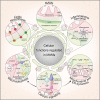ER-mitochondria signaling in Parkinson's disease
- PMID: 29497039
- PMCID: PMC5832754
- DOI: 10.1038/s41419-017-0079-3
ER-mitochondria signaling in Parkinson's disease
Abstract
Mitochondria form close physical contacts with a specialized domain of the endoplasmic reticulum (ER), known as the mitochondria-associated membrane (MAM). This association constitutes a key signaling hub to regulate several fundamental cellular processes. Alterations in ER-mitochondria signaling have pleiotropic effects on a variety of intracellular events resulting in mitochondrial damage, Ca2+ dyshomeostasis, ER stress and defects in lipid metabolism and autophagy. Intriguingly, many of these cellular processes are perturbed in neurodegenerative diseases. Furthermore, increasing evidence highlights that ER-mitochondria signaling contributes to these diseases, including Parkinson's disease (PD). PD is the second most common neurodegenerative disorder, for which effective mechanism-based treatments remain elusive. Several PD-related proteins localize at mitochondria or MAM and have been shown to participate in ER-mitochondria signaling regulation. Likewise, PD-related mutations have been shown to damage this signaling. Could ER-mitochondria associations be the link between pathogenic mechanisms involved in PD, providing a common mechanism? Would this provide a pharmacological target for treating this devastating disease? In this review, we aim to summarize the current knowledge of ER-mitochondria signaling and the recent evidence concerning damage to this signaling in PD.
Conflict of interest statement
The authors declare that they have no competing financial interests.
Figures




References
-
- Rodriguez-Arribas M. et al. Mitochondria-associated membranes (MAMs): overview and its role in Parkinson’s disease. Mol. Neurobiol. 54, 6287–6303 (2016). - PubMed
Publication types
MeSH terms
Grants and funding
LinkOut - more resources
Full Text Sources
Other Literature Sources
Medical
Miscellaneous

